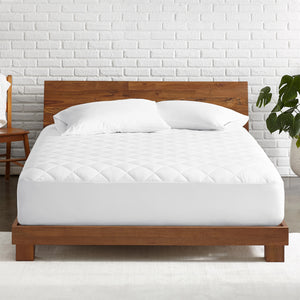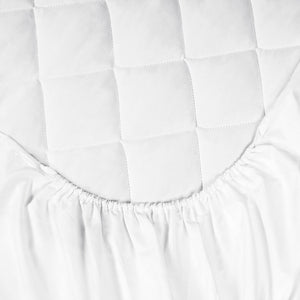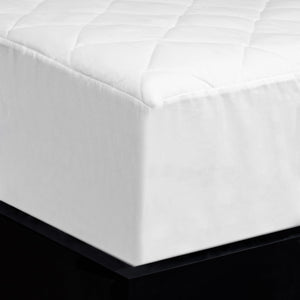How To Get Rid Of Mold On Your Mattress
It's really sneaky that mould spreads quickly. Mould spores are always present in the air, and warm, moist surfaces are ideal for their growth. Mould may already be a serious issue when you notice visual signs on a mattress (pink or black patches or stains).
Due to the warm and humid weather, mould is the most common issue with indoor air quality in the UK. Even if you maintain the cleanest home imaginably, mould may still grow. This is because mould spores need warmth and humidity to grow, and these conditions are just inescapable in the UK. In the case of mattresses, mould may become a significant issue when sweating results in excess moisture. Shop Mattress Protector From Yorkshire Bedding.
Another issue is that, since covers often cover it, the top of the mattress is something you see only sometimes. You will only recognise the surface of your mattress once you change and wash the sheets. Therefore, a mould problem can be undetected for many days or weeks.
The good news is that, while it takes some effort, it is relatively feasible to eradicate mould from a mattress.
Is Mattress Mold Dangerous? - Mold Side Effects
Most household moulds may be broken down into three groups:
- While certain "allergenic moulds" may need to be removed by a professional, most allergies may be eliminated at home with cleaning supplies.
- Disinfectants may be used to control "pathogenic mould," but big colonies need to be professionally removed.
- The most dangerous moulds are "toxic moulds," which need to be killed and any contaminated objects disposed of by a specialist.
Mould has the potential to bring about a broad variety of difficulties. Some people react to mould by getting stuffy noses, coughs, wheezes, itchy eyes, and rashes. People who have asthma or mould allergies may have severe responses. Those with weaker immune systems or persistent lung diseases are at an increased risk of developing respiratory mildew illnesses.
What Causes The Growth Of Mould On A Mattress?
Your mattress may grow mould due to germs and dampness. Mattress upkeep is critical for mould prevention in the bedroom. Though mould spores are constantly in the air, if you give them a humid environment to develop in, they will. As a result, you should remove any excess moisture from the space.
A Wet Ambient
If your bedroom is humid and you sweat, your mattress may mould fast. This is because sweating in a heated environment may cause mould to grow on your mattress. Mould spores feed from sweat because it has moisture. You must ventilate the space, lower the thermostat, and, if practical, use a dehumidifier to lessen moisture buildup. Shop Waterproof Mattress Protector.
Leaving Your Mattress On The Ground And Failing To Rotate It Every Month
Airflow is necessary for mattresses to prevent mould growth inside of them. Consequently, you have to keep your mattress off the ground. Mould can flourish in an atmosphere with heat and moisture if you leave it on the floor. Additionally, to avoid mould problems, you should always flip your mattress once a month.
How Does Mold Appear On A Mattress?
You may only sometimes be able to see mattress mould immediately, particularly if you regularly inspect your mattress thoroughly.
Smell
Mould and its spores emit a lingering, musty odour. Some individuals liken the smell of mould to that of decaying wood or damp socks.
Presence
You'll be aware when mould becomes evident to the naked eye. Mould on a mattress will seem different from any other blemish or stain on your bed. Growths may develop puffy patches that are pink or black.
Determinants Of Health
You should spend at least 8 hours every night in bed; therefore, if your mattress has mould, this prolonged period might lead to overexposure. Because of how mould exposure might damage your health, you could become aware of a problem. Mould exposure often exhibits symptoms similar to an allergy, such as headaches, congestion, tiredness, or itchy eyes or skin. If the person leaves the contaminated area to go to work or another place in the home, these symptoms will, however, diminish.
Top 6 Most Effective Methods For Removing Mold From A Mattress
How To Vacuum A Mattress To Remove Mold

Since inhaling mould at night may significantly harm your health, we want to check and clean our mattresses as thoroughly as possible. Does your bed contain mould? Mould removal and mould detection are suitable first actions.
- Double-check to determine if you are experiencing any mould in mattress symptoms.
- If you do, consider a mould removal strategy for your mattress.
- Clean the whole mattress using the vacuum's most minor attachment.
- Pay special attention to the areas of your mattress or comforters that have water damage while vacuuming.
- Vacuuming is only one method for removing mould from a mattress without causing health problems or allergic responses.
How To Remove Mold From A Mattress With Sunlight
Usually, if you have water damage, you must place a mouldy mattress outside in the sun to dry it.

According to studies, the sun's UV rays can kill microorganisms. They may eliminate the mould on your mattress thanks to such qualities. Additionally, your mattress will be dried by it. Getting your mattress fully dry can prevent mould development since mould prefers moist environments.
- Remove all the sheets off your mattress and set it outdoors in the bright sunlight. Ensure the weather will be warm and dry since this would worsen the issue.
- Exposing your mattress in the sunshine, even for only 15 minutes, is preferable, even if you try other techniques.
- When you use solvent cleaners or if there has recently been water damage, this will totally dry your mattress.
- Unfortunately, it may not dry entirely by sitting indoors. Additionally, you need it to be as dry as possible if you have a mould issue.
How To Clean A Mattress Of Mold Using Rubbing Alcohol
You may use rubbing alcohol as a potent disinfectant all around your house, even on hard surfaces. It eliminates pathogens and even stops the development of new bacteria. It is not surprising that alcohol may help fix a mouldy mattress.

Bacteria may flourish in the wet places left behind after water damage to your property. To keep microorganisms at bay, however, possessing a tool like rubbing alcohol may help you avoid the need for extensive mould cleanup.
- Look for rubbing alcohol with a concentration of 60–90%. Do not rely just on rubbing alcohol. Make an alcohol and water combination that is around 50/50 for safety.
- Now, dab the rubbing alcohol over the visible spots.
- If you don't have to rub alcohol on hand, you may do the same procedure using hydrogen peroxide in a 3-to-1 water-to-chemical ratio.
- Nevertheless, you must use it if your mattress permits bleach cleaning. First, check the tag!
Important Note: A vacuum and sunshine may clean the whole mattress; however, alcohol treatment is primarily a spot treatment. Therefore, if there are a few tiny stains, this will specifically target the problematic areas.
How To Remove Mold From A Mattress Using Homemade Cleaners
You may use less dangerous chemicals if handling strong chemicals like rubbing alcohol on your bed doesn't appeal to you. Here are some common concoctions you may create on your own using items you already have at home:
Baking Soda: To make a paste, combine it with a little warm water and vinegar, then use it to remove stains. Even non-mould stains may be treated with this.
Lemon Juice: Spray it evenly over the mattress after combining it with warm water.
Anytime you use a liquid cleaner like this, you must always completely dry it. The mattress should be left in the sun for the most outstanding results. This will further eliminate microorganisms while drying the mattress, as already explained.
How To Remove Mold From A Mattress Using Tea Tree Oil And Vodka
Tea tree oil and vodka may create yet another treatment for mattress mould. For mattress mildew removal, use this solution with a spray bottle.
- Spray the whole bed to completely cover the mattress across all sides to disinfect a mattress.
- Exposing the mould to alcohol must result in its instant death.
- Give it an hour to dry. To confirm that the mould has been completely removed, vacuum the entire mattress from top to bottom.
- Cover the pillow top and slats to remove mould development, then allow the mattress to air dry.
- Ensure thoroughly wash the rags and wring out all the used water.
- Use this organic mould treatment to clean your bedroom of mould and mildew.
Mattress Disposal & Professional Cleaning
Consider purchasing a new bed if the mould is still there after we have tried every disinfectant you can think of, including soda, vacuum, and alcohol. Mould on a mattress can be difficult to eradicate if you don't know what you're doing. We will have to get rid of it since resting on a sick mattress will shorten our lives.
Professional cleaners are available to sterilise your mattress till it is spotless. Getting in touch with them is your last resort. They could also provide suggestions for removing mildew from clothing.
Some Prevention Tips For The Future
Above are a handful of valuable hints to assist you in avoiding future unpleasant mould development.
Dehumidifiers Should Be Used In Bedrooms
A moist or wet mattress can dry relatively fast if you live in a warm, dry area, mainly if numerous windows are left open to promote air circulation. For people in humid regions, positioning a fan or dehumidifier next to the mattress might further hasten the drying process. If the region you've been drying out is relatively tiny, you can do it fast using a hair dryer.
Utilising a dehumidifier to reduce the humidity in the bedroom can aid in preventing further mould development since mould grows best in moist settings.
When You Leave, Don't Stop The Airflow
When leaving their houses, people often turn off air conditioners, fans, dehumidifiers, or air purifiers. An innovative technique to help stop future mould development is leaving air-circulating equipment running with time-controlled settings to ensure safety.
Put A Room Air Purifier To Good Use
The air in the bedroom will be filtered and circulated with the aid of an air purifier. An air purifier may actively eliminate mould spores in the air and stop them from spreading further by using the right kind.
Make Sure There Is Ventilation To The Mattress's Bottom
Purchasing a slatted bed foundation will enable sufficient airflow to reach the top of the mattress and both sides. Slatted bed bases, as opposed to conventional box springs and flat top bases, can help stop mould from growing on your mattress's bottom.
Use A Mattress Protector To Preserve The Life Of Your Bed
You must take action to lessen the issue if your mattress shows apparent indications of mould. Although challenging, this task must be done. Make adjustments to your interior airflow and air quality to avoid future occurrences.

Investing in a fresh mattress protector is another option. You should always use a waterproof cover to prevent mould from growing on your new mattress. Better sleep is essential to us at Yorkshire Bedding, and part of that is ensuring that our customers have a safe, mould-free place to rest their heads each night. Yorkshire Bedding provides everything you need, including a mattress protector for a secure place to lay your head at night.








